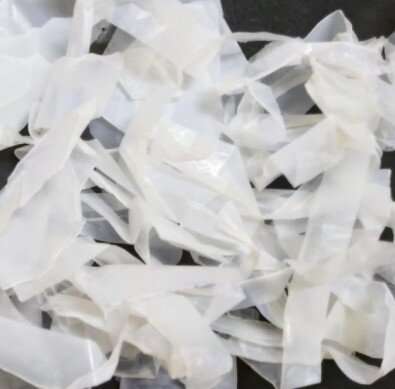
In Brazil, researchers at São
Paulo State University (UNESP) in Ilha Solteira have developed a film that can
replace plastic in food packaging. The film is made from hydroxypropyl
methylcellulose (HPMC) and bacterial cellulose scraps left over from industrial
processing. Both raw materials are sustainable. They are combined to produce a
biodegradable film of bacterial cellulose nanocrystals and HPMC.
The product outperforms film made of HPMC alone. An article on the research project, which was supported by FAPESP, is published in the journal ACS Applied Material & Interfaces.
"We set out to fill the HMPC matrix with bacterial cellulose nanocrystals in order to enhance its properties. We also wanted to create greener protocols for the development of novel composites, from the material itself to its origin, so we included the reuse of industrial waste in the project," said Márcia Regina de Moura Aouada, a co-author of the article. Aouada has a Ph.D. in chemistry from UNESP, where she teaches and is a researcher at the Center for Development of Functional Materials (CDMF), one of the Research, Innovation and Dissemination Centers (RIDCs) supported by FAPESP.
Since her Ph.D., Aouada has studied films made from renewables, and edible and biodegradable films, with the aim of reducing the growing generation of solid waste in the form of dumped plastic food packaging.
"One of the limitations of films made of HPMC and other biopolymers is their low mechanical strength compared with traditional films derived from petroleum. They are also highly permeable to water vapor, which limits the available applications. We improved these properties by adding bacterial cellulose," said Pamela Melo, a graduate student in material sciences at UNESP and first author of the article on the project, which was conducted during her Ph.D. research under Aouada's supervision.
Cake recipe
The researchers obtained bacterial cellulose scraps from Seven Indústria de Produtos Biotecnológicos, which makes wound dressing biofilms in the state of Paraná. To convert this waste into film suitable for food packaging, they first milled the scraps into powder. "We then submitted the powder to sulfuric acid hydrolysis, a process well described in the literature," Melo said. The result was a bacterial cellulose nanocrystal suspension, which they mixed with HPMC diluted in water to produce a film-forming dispersion, a target of interest for the bioplastics industry.
"It's not enough to create good composites. We need to find the best solution to obtain good film properties by varying factors such as viscosity and nanoparticle concentration. A fair analogy could be a cake recipe: studying the recipe is another significant innovation in our study," Aouada said.
"How the nanocrystals interact with the HPMC matrix and are distributed within it will determine film quality, so we conducted tests and arrived at the optimal distribution via high-energy dispersion using a Turrax disperser," Melo said. The film-forming dispersion was deposited on a substrate. The solvents evaporated after 24-48 hours. The result was a stronger, less permeable product than HPMC-only film. The amount of water absorbed by the material is currently a constraint on its use in packaging.
Another positive finding is that the nanocrystals do not alter the transparency of HPMC.
Advantages of bacterial cellulose
Cellulose is the most abundant polymer in nature and the main component of vegetable fibers, providing rigidity for plants. Plant cellulose is well-known and used in the manufacturing of paper, but some bacteria, algae and marine invertebrates also secrete cellulose, which has been used for some time in wound dressing biofilms and is now expanding into other areas, such as food packaging.
Protection of the natural environment benefits most. "Bacterial cellulose can be produced in the laboratory all year round, regardless of weather and environmental conditions. It's a purer molecule and the production process generates less pollution," Aouada said. Processing of plant cellulose requires the elimination of impurities such as lignin using organochlorine compounds, which are harmful to the environment.
Another advantage of bacterial cellulose is the presence of nanometric fibers in its structure. "This is very interesting because it gives the material distinct properties such as high tensile strength, meaning it can withstand certain loads or stresses without breaking," Aouada said.
Next steps
The researchers plan to continue testing film-forming dispersions until they conclude they have developed a competitive product. They are studying other polymer dispersion techniques, comparing them with the use of HPMC, and assessing their biodegradability.
If they succeed in developing better film-forming dispersions, it may be possible to use bacterial cellulose on a larger scale. "Our main focus is on finding substitutes for materials not considered ecologically correct, such as petroleum products. Such substitutes include biodegradable composites derived from renewable resources," Aouada said.
The use of cellulose scraps and other kinds of waste also helps reduce processing cost. Consumers typically prefer plastic film for packaging because it is cheap. Moreover, there are other promising sources of bacterial cellulose, such as the sugarcane and soy industries. "Studies have shown that bacterial cellulose can be obtained using sugarcane or soy molasses as a substrate," Aouada said.

 Previous page
Previous page Back to top
Back to top







